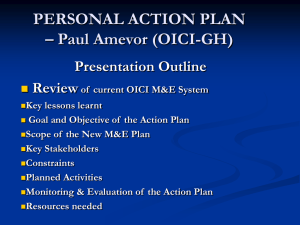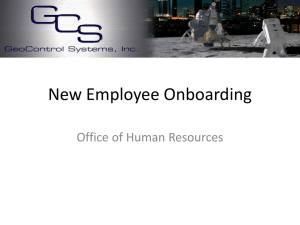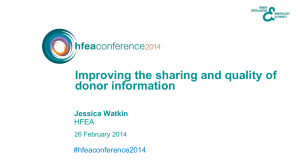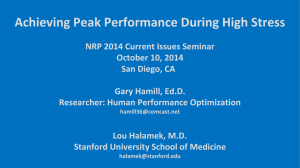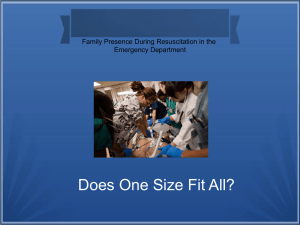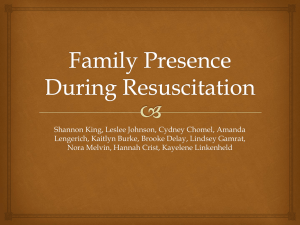Donor Case Studies
advertisement
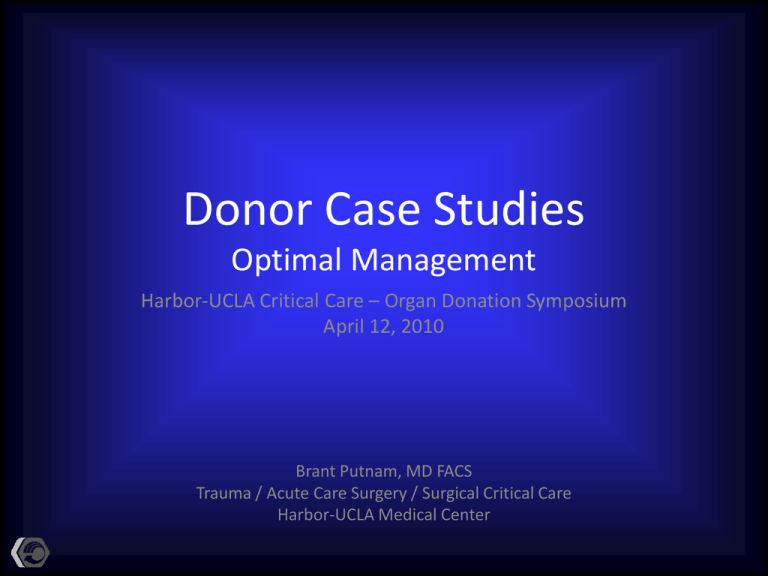
Donor Case Studies Optimal Management Harbor-UCLA Critical Care – Organ Donation Symposium April 12, 2010 Brant Putnam, MD FACS Trauma / Acute Care Surgery / Surgical Critical Care Harbor-UCLA Medical Center What is OPTIMAL donor management? = GOOD CRITICAL CARE OPTIMAL donor management begins PRIOR to proclamation of brain death. The ICU nurses and physicians are jointly responsible for optimal donor management, not just the OPO. If the patient has not been formally pronounced brain dead, then the patient is alive. Who is not willing to provide good critical care to a live patient? NO ONE Case #1 63yo male found lying against a wall Possible fall vs. assault Large laceration to occipital area GCS 1-4-1 Pupils sluggish Case #1 Called as a “Tier II” (high acuity) trauma A - Patent, but not protected B - Spontaneous, clear bilaterally C - P = 86 BP – 150 D - Unresponsive GCS = 1-4-1 Pupils 32, sluggish Blood from left ear Case #1 Intubated in the ED for airway protection Taken for CT scan for suspected severe traumatic brain injury Multiple intraparenchymal hemorrhages Large left subdural hematoma (w/ midline shift) Case #1 Neurosurgery consultation To OR immediately for bilateral craniectomy + evacuation ICH and SDH GCS 1-1-1 Coagulopathic and HD unstable intra-op Prognosis deemed poor leaving the OR Case #1 Patient transported to ICU Time BP P 0400 2200 140/70 140/70 90 85 2300 160/80 110 0000 80/60 60 0100 100/70 100 Labetalol given Levophed started What do you think happened here? Case #1: So to review… Time 2200 2300 0000 0100 BP 140/70 160/80 80/60 100/70 P 85 110 60 100 Pupils 4, sluggish 4 mm,NR 6 mm, NR 6 mm, NR Motor Flexor pos Flexor pos No movement No movement Cough + + - - Herniation Brain Herniation Often accompanied by catecholamine storm Hypertension Tachycardia Avoid anti-hypertensives Management Goal #1 Appropriate hemodynamic resuscitation to maintain perfusion to potential organs for donation Maintain MAP 65-100 mmHg Place central venous line; fluid resuscitation to CVP 4-10 cm H20 Use of < 1 vasopressor Dopamine < 10 mcg/kg/min Levophed < 10 mcg/min Neosynephrine < 60 mcg/min Consider hormonal resuscitation with T4 protocol What should happen next?? Begin testing for brain death One Legacy notification (actually should have already been notified!!!) Clinical optimization When to notify One Legacy… Case #1: What did happen…. Next morning… 1200 noon One Legacy notified Physician to hold family conference to discuss poor prognosis No new orders written… No new orders written… Time 0800 1200 1800 2400 24 hr total UOP 300 250 300 100 - 1000 cc Na 153 158 164 165 165 What do you think is going on here? Management? Diabetes Insipidus Excretion of large amounts of severely dilute urine “Central” – no ADH release from brain Kidney can not concentrate urine Therapy DDAVP (desmopressin acetate) Synthetic Free analogue of ADH water replacement Frequent monitoring of serum Na What was done… DDAVP given at 1900 Time UOP Na 0800 300 153 1200 250 158 1800 300 164 2400 100 165 Free water replacement started next morning (POD #2)… M.D. “brain death evaluation when electrolytes correct” Management Goal #2 Maintain perfusion to all organs Goal urine output 1-3 cc/kg/hr Suspect DI if U/O > 200 cc/hr x 2 hrs Treat with DDAVP and fluid (free H2O) Keep serum Na 135-155 Meanwhile… POD #3 Time 0000 0600 1200 1800 2400 Glucose 219 160 406 465 398 Management? Insulin drip finally started next morning at 0900 Management Goal #3 Potential donors are critically ill patients Tight glucose control applies Increase frequency of Accu-checks Increase sliding scale Insulin drip as needed Goal is to keep serum glucose < 150 As time passes . . . Multiple ventilator alarms PIPs 45-50 Low exhaled tidal volumes O2 sats 85% Increase TVs to 1 L to maintain sats 88-90% Is this the best ventilator management? Management Goal #4 Maintain good oxygenation PaO2/FiO2 ratio > 300 Reduce FiO2 to reduce oxygen toxicity Avoid high PEEP effects on hemodynamics Maintain adequate ventilation ABG pH 7.30-7.45 Avoid barotrauma to lungs PIPs < 32 cm H20 Case #1: POD #4 0300 1st Brain Death Note written (Note: 75 hours after herniation event) 1000 2nd Brain Death Note written 1455 One Legacy obtains consent for all organs and tissue Case #1: Outcome HD deterioration to near-code Poor organ function Crashed donor to OR because of instability Kidneys recovered Kidney biopsy results poor No organs suitable for transplant Case #2 – Getting it right . . . 22yo male S/P pedestrian struck by auto x 2 GCS 1-1-1 Lost pulses on arrival; CPR x 12 min Devastating brain injury One Legacy notified within 4 hours of arrival Case #2 Case #2 Ongoing resuscitation IV fluid to CVP 8 Blood products to keep Hb near 10 Correction of coagulopathy Use of Levophed to maintain MAP > 65 Addition of T4 within 4 hours Adequate oxygenation / ventilation ABG 7.39 / 40 / 118 / 24 / -2 / 99% PaO2 / FiO2 = 350 PIPs 22-24 Case #2 Early treatment of DI DDAVP Free water replacement Na 150-154 Tight glycemic control with insulin drip Loss of brainstem functions First BD note < 12 hours after arrival Case #2 Outcome - 7 organs transplanted at local centers: Right lung Left lung Heart Liver Right kidney Left kidney Pancreas Case #3: Steven 17yo male S/P skateboarding accident GCS 1-1-1 Severe DAI, small SDH on CT scan Devastating brain injury Case #3: Steven Donor Management Goals Appropriate hemodynamic resuscitation MAP 65-100 ALL organs CVP 4-10 Lungs, ALL EF 50-70% Heart, ALL Use of < 1 vasopressor Heart, ALL Hormonal resuscitation with T4 protocol ALL Donor Management Goals Good oxygenation / ventilation PaO2/FiO2 ratio Lungs ABG pH 7.30-7.45 Lungs, ALL PIPs < 32 cm H20 Lungs Urine output 1-3 cc/kg/hr Kidney Serum Na 135-155 Liver Pancreas Glucose < 150



